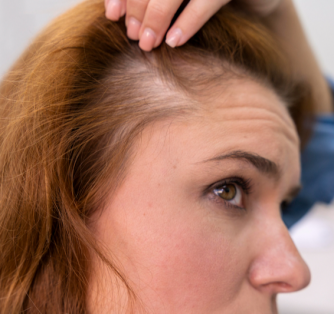Menu
Weight loss
Hormones
Sex
EXPLORE
MEET NU IMAGE MEDICAL
TREATMENTS
MEET NU IMAGE MEDICAL
TREATMENTS
MEET NU IMAGE MEDICAL
Everything You Need To Know About Minoxidil For Women


Have you started to notice more hair in the drain after you shower? Maybe you’re seeing more shedding every time you brush, or you notice that your part seems to be changing. These are all signs of hair loss for women and unlike what many people think, women do experience it! In fact, according to the Journal of the American Academy of Dermatology, female pattern hair loss (FHPL) affects around 40% of all women by the age of 50.
In reality, there are many reasons women lose their hair, from hormone changes and genetics to stress and diet. Thinning hair can be alarming, but hair loss is a particularly emotional topic for women. Not only does hair have a deep connection to feelings of femininity, but society doesn't like to recognize the problem. This leaves lots of women to silently struggle and feel alone in their battle against hair loss. Fortunately, treatments like Minoxidil can successfully promote regrowth in women, just like it does for men.
Minoxidil is one of the key ingredients in our proprietary blend of topical hair loss treatments for women and men. If you’d like to learn more about it, get started with our medical intake form.
Is Minoxidil Safe For Women?
Minoxidil is an FDA-approved treatment for female pattern baldness, including androgenetic alopecia. When used as recommended, it can help stop hair loss and promote hair regrowth. There are two forms of minoxidil that women can use to fight thinning hair: a 2% topical solution and a 5% topical foam.
Minoxidil is not a new medication. In fact, it was used in the 1960s to treat high blood pressure when its positive benefits on hair regrowth were first noted. After additional research, topical minoxidil was approved for men and then later for women. Minoxidil can be bought over the counter under the popular name brands Rogaine or Women’s Rogaine.
Not only is minoxidil safe, but it is also an effective medication to help women reduce hair loss and promote healthy growth.
How do Women Use Minoxidil to Treat Hair Loss?
Female hair loss tends to be progressive and similar to what men experience, but it doesn’t follow the same pattern. For instance, men often have a receding hairline and thinning crown that leads to baldness. Women, on the other hand, experience overall thinning, a widening of their parts or receding around the temples, but do not usually go bald. The result can be thin, brittle, and sparse hair.
Women can use Minoxidil to stop this type of thinning, but it is more effective in treating hair loss when it is started early and used consistently.
Women can use Minoxidil to:
-
Reduce excessive hair shedding
-
Promote new hair growth
-
Increase hair thickness and overall hair density
Minoxidil is applied topically to a dry, clean scalp. Depending on the formulation, this needs to be done one or two times a day. It is important to try to apply Minoxidil directly to the scalp where hair loss is occurring and not to wash your hair for at least four hours after application. You’ll want to wash your hands after application and make sure that you don’t accidentally get it on other areas because it can promote unwanted hair growth.
Side Effects of Minoxidil on Women
Women can safely use minoxidil to treat hair loss, but like all medications, side effects can occur. Because Minoxidil is applied topically, however, most side effects are topical, such as minor skin irritations.
Women using minoxidil may experience the following side effects:
-
Irritation and redness on areas of application
-
Burning and itching after application.
-
Flaking of the scalp
-
Hair growth in unwanted areas
Treatments can be combined to help reduce skin irritation and flaking, such as using Ketoconazole to promote scalp health. Washing hands and limiting contact with Minoxidil with other parts of the face and body can reduce the chances of developing unwanted hair growth. Sometimes people opt to use a lower concentration of minoxidil if excessive scalp irritation occurs.
Less commonly, some people experience headaches, nausea, reduced blood pressure, or heart palpitations. According to the Mayo Clinic, these types of reactions are rare. While there seems to be some evidence linking Minoxidil to reduced sperm counts in men, it does not appear to impact female fertility in any way. It’s important to note, however, that women who are pregnant, trying to get pregnant or breastfeeding, should not use Minoxidil.
As with all medications, it is important that women use Minoxidil as recommended to reduce the occurrence of side effects. It is also important to start treating hair loss as soon as possible because hair’s natural growth cycles take time and hair loss can be quick and progressive. This means consistent, long-term use is key to stopping shedding, increasing density, and regrowing hair.
How Do You Get Minoxidil for Women?
Lower dosages of Minoxidil are available over the counter, without a doctor’s prescription. If you have more questions about hair loss treatments for women, we invite you to consult with one of Nu Image Medical’s physicians, all of whom are based in the United States. Begin by completing a confidential and secure medical intake form. We’ll review that and be in touch within 48 hours with the next steps in your hair-loss treatment.
GET STARTED NOW
This article is for informational purposes only and does not constitute medical advice. The information contained herein is not a substitute for and should never be relied upon for professional medical advice. Always talk to your physician about the risks and benefits of any treatment. Nu Image Medical may not offer the medications or services mentioned in this article.
